Album Weeds – Braunschweig (Brunswick)
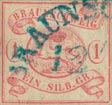 1852. 1 Silbergroschen, rose.
1852. 1 Silbergroschen, rose.
Genuine
Engraved in epargné, on thick, white wove paper, unwatermarked, backed with rose-colourecl gum. The outer frame of the stamp is composed of two lines, not at all blotched together, the outer one very much thicker than the inner one. The impression is frequently poor; that is to say, the vertical lines in the central oval are often not complete, some of them being only drawn part of the way, or else broken. None of the letters touch each other anywhere. The central oval has its outline formed by two thin lines, part of the way; i.e., from about the end of the tail, over the back, round to about level with the eyes of the horse; all the rest of the outline of the oval is quite solid, formed by the two thin lines being merged into one thick one. The little dark cross on the top of the crown is moderately distinct, and it just touches the inner outline of the oval above it. This cross rests on an oval white orb, which has an oval ring of colour in its center. On the crown, below the orb, are two ovals, very similar to the orb in all respects. At the base of the crown are four very small white pearls, but these are very difficult to see, as the band forming the base of the crown is generally more or less blotched. The crown touches the mane of the horse. There are 19 vertical lines of shading in the left side of the oval, counting along the top outline as far as the cross and 17 lines in the right side of the oval, counting from the other side of the cross; or, reckoning 3 lines as hidden by the cross, there would be 37 in all. (There is, at the left-hand end of the oval, in most copies, a portion of another vertical line, joined to the end of the oval, but I do not reckon this.) The piece of ground on which the horse stands does not touch the outline of the oval on either side. Below this piece of ground, between it and the lower outline of the oval, are a number of short, vertical lines of shading, of varying lengths, intended for the lower ends of the long vertical lines spoken of above. There are about 18 of them, but some are mere dots. The seventh, eighth, and ninth of these, counting from the left, break into the outline of the piece of ground above them. The eye, nostril, and mouth of the horse are tolerably distinct; the line forming the front curve of the shoulder is well marked, and there is a long, curved line running up the neck, not parallel with •either outline of the neck. The point of the horse’s nose comes between the sixth and seventh of the vertical lines, counting from the left; and the front hoof touches the first vertical line. The tail ends between the first and second vertical lines from the right.
First Forgery
Lithographed, on thick, hard, very white wove paper; white gum. In the word BRAUNSCHWEIG, the letters RA touch each other at the bottom, and WE, and sometimes HWE, touch each other at the top. The letters GR. in the lower label also touch each other at the bottom. There is a thick vertical line at the top of the crown, to represent the cross, but its cross-bar seems to form a part of the orb. The orb on which it rests is circular, with a crescent-shaped line of shading in the center of it. The middle of the crown does not show the two oval openings. There are five pearls at the base of the crown, four of them being very distinct. There are 20 vertical lines of shading in the left side of the oval, as far as the cross, and 18 similar lines in the right side of the oval. The piece of ground on which the horse stands is joined to the outline of the oval on the right. There are 20 short, vertical lines below the piece of ground, but none of them break through the outline of the said piece of ground. The nostril and mouth of the horse are generally one blotch. The point of its nose touches the seventh vertical line from the left, and the front hoof comes between the first and second vertical lines. The end of the tail touches the first vertical line on the right. The front outline of the neck looks rather ragged, and the line of shading, running up the neck, is very nearly parallel to the front outline of the neck. The tail of the R of GR. runs into the stop after it, though it does not do so in the genuine.
Second Forgery
Lithographed, on thin, rather hard, white wove paper; white gum. On the left side of the stamp, the two lines of the outer frame are both of the same thickness, and on the other three sides also there is very little difference in the thickness of the two lines. Instead of a cross on the crown, there is a little ball, and the orb is round, with a white center, and no ring in it. Below the orb there is a white, upright oblong, which is not seen in the genuine. The oval openings in the crown are absent, and the pearls at the base of the crown are undecipherable. The crown only just touches the mane of the horse. There are 18 vertical lines on the left side of the oval, as far as the ball, and 15 on the right side of it. The piece of ground on which the horse stands touches the oval on the left side, but not on the right. There are no short vertical lines below this piece of ground, but the lower outline of it is interrupted in the center, and shows there four tiny, vertical lines, which have no business there. There is no dark line to mark the rounded curve of the shoulder, and no line up the neck. The point of the horse’s nose breaks the sixth vertical line from the left, and the front hoof comes between the first and second lines, the first line not coming down to touch the hoof. The tail does not quite touch the first line on the right. This forgery is better executed than the first, though the details are not so correct.
Third Forgery
Lithographed, in rose, and also in vermilion, on medium, white or yellowish-white wove paper; white gum. The two lines of the frame are rather blotched together at the top, and, all round, there is not sufficient difference between them in thickness. The two outlines of the oval are separate most of the way round, being only merged into one solid line, from below the hind feet of the horse to about level with the knees of the fore-legs. In the word BRAUNSCHWEIG, the letters RA are joined at the bottom, and HVVE at the top. The orb on the crown has an oblong, white patch in its center, and there is no cross on the top of the orb, but merely a very small, dark lump. In the center of the crown there are two large, distinct white pearls, to represent the oval openings of the genuine. There are four small white pearls at the base of the crown. The crown itself does not touch the horse’s mane. As the lump or blotch, intended for the cross, does not touch the outline of the oval above it, the vertical lines of shading in the oval can be counted all the way round, and there are 42 of them. The piece of ground on which the horse stands touches the oval on the right, but not on the left. There are 21 short vertical lines below this piece of ground, but none of them break through the lower outline of the piece of ground. The horse has a distinct, round eye, but there is no mouth or nostril. The bottom of the mane, where it lies on the back of the horse, is a blotchy lump of colour. The point of the nose touches the ninth line from the left. The front hoof touches the third vertical line, and is curved too much inwards. The end of the tail touches the fourth line from the right. It will be seen that this forgery is very different from the genuine.
Fourth Forgery
This, except that it is too pale, is very like the genuine in general appearance. Lithographed, on medium, white wove paper; white gum The two outlines of the frame are somewhat blotched together at the top. The outline of the central oval is solid, nearly all the way round. The orb is circular, with a white center, and no oval ring in it. The crown is very light in colour, and its details are not to be deciphered; indeed, it is invisible at a first glance, whereas, in the genuine, it is the darkest object in the oval. It does not touch the horse’s mane. There are 18 vertical lines of shading to the left of the cross, and 16 to the right of it. The ground on which the horse stands appears to touch the oval both sides, and the short lines below it are so broken and imperfect that they cannot be counted. I ought to add that this arises from imperfect inking of the stone, so the lines may be all right, as far as I know. The front of the shoulder is formed by a short, oblique line, not curved as the genuine is, and there is no line up the neck. The point of the horse’s nose touches the eighth line from the left; the front of the leg (the hoof is curled inwards) touches the third line from the left, and the tail touches the third line from the right.
Fifth Forgery
Engraved in epargné (probably an electrotype), on thick, white wove paper; yellowish-brown gum. The two lines forming the frame are blotched together the whole way round, and, as far as I can make out, the inner line is thicker than the outer one. All the colored parts of this forgery are deeply sunk into the paper, far more so than the genuine. In my specimen, the upper outline of the lower scroll, which contains EIN SLLB. GR., is broken nearly all the way along; but this is only from absence of ink, as the sunken impression of the die can plainly be seen, though the ink has failed. The outline of the oval is solid all the way round, and, at the bottom, it is evidently composed of one thin line, though in the genuine, and in all the other forgeries, it is, at this part, a thick line, formed by the two thin lines being merged together. As far as I can make out, there are 18 lines to the left of the cross, and 15 to the right of it. There is no line up the neck of the horse. The piece of ground on which he stands touches the oval both sides, and there are no vertical lines below the said piece of ground. I cannot give any further details, as my specimen is so extremely faint.
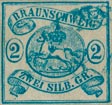 1852. 2 Sgr., blue.
1852. 2 Sgr., blue.
Genuine
Paper, engraving, gum, etc., as in the genuine 1 Sgr. The outer frame is also the same as in the genuine 1 Sgr. The bottoms of the R and A of BRAUNSCHWEIG generally touch each other, but not always. The two nullities of the central oval are merged into one solid line, from about level with the back of the horse, round underneath, to about the tenth line from (he left; that is to say, perpendicularly above the eye of the horse. The rest of the outline, as before, is composed of two separate lines. The cross on the crown is the same as before, but the oval ring in 1 lie center of the orb appears to be here only a curved or crescent-shaped line, instead of a complete ring. The base of the crown contains an upright diamond, with a transverse diamond on each side of it. These are fairly distinct. The crown touches the mane of the horse. There are 22 vertical lines of shading on the left side of the oval, as far as the cross, and 18 similar lines from the cross to the right side of the oval; or 43 in all, if we suppose that 3 lines are hidden by the cross. The piece of ground on which the horse stands does not really touch the outline of the oval either side, though it goes very close to it on the right side. Below the piece of ground, between it and the lower outline of the oval, there are 22 very short, vertical lines, some being mere dots, as before. The eye, nostril, and mouth of the horse are moderately distinct; the line forming the curve of the shoulder is thick and heavy, and there is usually a line, running up the neck, which is very nearly parallel with the curve of the back of the neck. The point of the horse’s nose comes between the seventh and eighth of the vertical lines, counting from the left. The front hoof comes between the first and second lines, and sometimes it also touches the outline of the oval. The tail ends at the third vertical line from the right. The G of BRAUNSCHWEIG, and the G of GR. are both exactly alike, and the tail of each points downwards, and not forwards.
First Forgery
Lithographed, on thick, hard, very white wove paper; white gum. This is the same as the first forgery of the 1 sgr., and the tests for that counterfeit apply to this one. The tail of the G of BRAUNSCHWEIG curls forwards, and the tail of the G of GR. is bent forwards at a right angle, so as nearly to touch the R.
Second Forgery
Poorly lithographed, on thick, hard, yellowish-white wove paper, white gum. The inner line of the frame of the stamp is so very thin that, in some places, it is almost invisible. The R and A of BRAUNSCHWEIG are very distinctly joined together at the bottom. The oval, as far as I can make out, is composed of one single, thin line at the top, two thin lines at the right side, and one thick line at the bottom and left side, being very thick indeed at the bottom. The top of the crown is postmarked in my copy, so that I am unable to tell the shape of the cross; but it does not touch the upper outline of the oval, and the orb appears to be merely a shapeless, white blotch. The crown itself, as far as it is visible beneath the postmark on my specimen, is very dark and shapeless, with a white center. The cross, as I have said, does not touch the top of the oval, therefore the vertical lines can be counted all the way across from left to right, and there are 35 of them. The piece of ground on which the horse stands touches the oval, very distinctly, both sides. Of the short lines beneath the piece of ground, only about three or four can be seen in my specimen, and they are so exceedingly faint that I could only make them out with the microscope. The eye and nostril of the horse are tolerably distinct, but the mouth is hardly visible. The line forming the inner curve of the shoulder is very short and thick, and there is no line running up the neck; but, per contra, there is a short, thick vertical line, with a dot to the left of it, in the neck, just opposite to the point where the outline of the neck joins that of the back. The nose of the horse touches the sixth vertical line from the left. The front hoof touches the first line on the left. I ought to add that there is a blue line, apparently a scratch on the stone, which runs right across the stamp, from above the U of BRAUNSCHWEIG, through the left-hand end of the oval and the Z of ZWEI, to the bottom, and this line covers the place where the first vertical line of the oval ought to be. This long line is, of course, not to be seen in the genuine, or, indeed, in any other counterfeit. The tail ends at the third vertical line from the right.
Third Forgery
Engraved in epargné, on very yellowish-white wove paper, thick and hard, with yellowish gum. The outer line of the frame is irregular in thickness, and, on the right side, there are portions of it that are as thin as the inner line. The inner line is broken at the left lower corner, i.e., the left side and the bottom do not join. The R and A of BRAUNSCHWEIG appear to touch at the bottom. The lettering is all slightly sunk into the paper. The crown is not nearly so dark as in the genuine; it is too indistinct to show details, but the base is evidently a plain white band. It does not touch the mane of the horse. There are 18 vertical lines to the left of the cross, and 16 to right of it. The piece of ground on which the horse stands appears to touch the outline of the containing-oval at both ends, and the horse’s left heel touches the outline of the oval, though it does not do so in the genuine. The central oval is one solid line all the way round. There are about 17 short vertical lines under the piece of ground, between it and the bottom outline of the oval. The mouth and nostril of the horse are one indistinct blotch. The line forming the curve of the shoulder is a shapeless blotch, and there is no line up the neck. The point of the horse’s nose touches the eighth line from the left; the front hoof (very much curled in) touches the third line from the left, and the tail ends at the third line from the right. There is one very easy test for this forgery. In the genuine, the “2” in each side-oval has a perfectly straight foot, with a little oblique line sticking up from the end of it. In this counterfeit, the foot of each “2” is curved, i.e., it has a wave in it.
Fourth Forgery
This stamp appears to be a lithographic transfer of the counterfeit just described. Lithographed, on thick, very hard wove paper. The gum is rose-tinted, and the tint has very slightly colored the stamp all through, so that it is pinkish-white. The tests are the same as in the third forgery; and, in addition, the cross-bar to the A of BRAUNSCHWEIG is not horizontal, but slopes down very much to the left. The cross-bar to the tail of the G of this word is so long, that it touches the inside of the body of the letter.
Fifth Forgery
Lithographed, on thick, very hard, yellowish-white or bluish-white wove paper. There is a scratch in the U and a stop after the G of BRAUNSCHWEIG, which are not found in the genuine. The thin, inner line of the frame is absent, part of the way along the top and the left side. The crown is a fair imitation of the genuine ; but the base of the crown bears a very tiny, white dot, with a pearl to the left of it, and a rather shapeless, white oblong to the right of it. In some copies, the said base appears to show a blotch at each end, and two colored dots in the center, the rest being white. It is quite impossible to count the vertical lines in the oval, as more than half of them are defective, or all together missing. The left-hand end of the piece of ground on which the horse stands just touches the outline of the oval, and the horse’s hind hoof touches the outline on the right side. Below the piece of ground, and between it and the bottom outline of the oval, there are only a few remnants of the short, vertical lines, which cannot be counted. The eye and nostril of the horse are fairly distinct, but the mouth is very faint. The line forming the curve of the shoulder is very thin, and there is no line running up the neck. The end of the tail goes beyond the last visible vertical line in the oval in my specimen, but there is room to the right of this for at least two other lines, so there may be more in a perfect copy, for anything that I know. This forgery, despite all the tests given, is fairly deceptive. The B of BRAUNSCHWEIG, which is a good deal too large in all the other counterfeits, is very like the genuine in this forgery. Perhaps the easiest test is the position of the cross on the crown. In the genuine, it is under the space between SC of BRAUNSCHWEIG, but in this forgery, it is under the beginning of the C.
 1852. 3 Sgr., vermilion.
1852. 3 Sgr., vermilion.
Genuine
Paper, engraving, gum, etc., the same as in the genuine 1 and 2 Sgr. None of the letters touch each other. The outline of the central oval is almost exactly the same as in the genuine 1 Sgr. The crown, orb, and cross are similar to those of the genuine 1 Sgr., but the ornaments on the base of the crown are seldom distinct enough to be made out. The crown does not seem to touch the mane of the horse. There are 19 vertical lines of shading in the oval, to the left of the cross, and 17 to the right of it, just as in the genuine 1 Sgr. This does not include the short portion of a line to the very left of the oval, which is visible in some copies, but not in others. The piece of ground on which the horse stands touches, by means of a dark prolongation of the lower line, the outline of the oval to the left, but it does not touch to the right. There are 17 short, vertical lines below the piece of ground. The eye, nostril, and mouth of the horse are tolerably distinct. The line forming the curve of the shoulder is strongly bent, somewhat like a sickle. There is a rather short line up the neck, which does not follow either outline of the neck. The point of the horse’s nose comes between the sixth and seventh line from the left, as in the 1 Sgr. The front hoof also touches the first vertical line, and the tail touches the second line from the right. There are five sloping lines of shading before the B, and two after the G, of BRAUNSCHWEIG, three long lines and a short one before the D of DREI, and one long one after GR. The stop after SILB. and the stop after GR. are both at the same distance from their respective words.
First Forgery
Lithographed, in carmine, on medium, white wove paper, white gum This is very like the first forgery of the 1 Sgr., with altered value. The tail of the G of GR. is like the genuine in this forgery. There are two long lines and one short one after the G of BRAUNSCHWEIG, two long ones and a couple of dots like a colon, before the D of DREI, and two long ones and a broken one after GR.
Second Forgery
This is much the same as the third forgery of the 1 Silbergroschen. Lithographed, in pale rose, on thick, hard, yellowish-white wove paper, rose gum. The letters RA of BRAUNSCHWEIG are joined at the bottom, and HWE at the top. The two outlines of the central oval are separate for most of the way round, as in the forgery named. The crown is also the same as in the said forgery. There are 43 vertical lines in the oval, and most of them have been drawn too long, so that they trespass, more or less, across the two outlines of the containing-oval, especially under the H and E of BRAUNSCHWEIG. The piece of ground on which the horse stands does not touch the oval either side. There are 21 short, vertical lines below the piece of ground. There is a slight indication of an eye, but the mouth and nose of the horse are not visible. There are three converging lines where the left front leg joins the body, and the line up the neck is very long and very thin. The point of the nose touches the ninth line from the left, the front hoof touches the third line from the left, and the tail ends at the third line from the right. By the way, I ought to mention that the last vertical line to the right is almost merged into the outline of the oval. There are four long, sloping lines, with another line crossing one of them obliquely, before the B of BRAUNSCHWEIG, and five short ones, of varying length, after the G. In all my specimens, the lines before the D of DREI are ail blotched into a solid mass of colour; and there are two long lines, and two short ones, after GR. The stop after SILB. is much smaller than the one after GR., and the latter is farther away from its word than the former is. Each “3” is tall and narrow, unlike the sturdy numerals of the genuine.
1853. Black impression, on colored paper.
The stamps are the same as the first issue, except that they are printed in black, on unwatermarked, colored paper, instead of in colour on white; thus the tests given for the first issue (save as regards the paper) will serve for these.
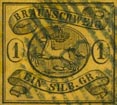 1853. 1 Silbergroschen.
1853. 1 Silbergroschen.
Genuine
Engraved, as before, in epargné, on yellow or orange-yellow wove paper, watermarked with a framed post-horn. The watermark is an easy test for all the stamps of this issue, as it is always plainly visible, and the forgers have not yet imitated it.
First Forgery
Nicely lithographed, in black, on yellow, orange, buff, or yellow-brown wove paper; no watermark. The paper is a little thinner than the genuine, and the colour of the yellow is a very exact imitation of the genuine; but that of the orange lacks the sort of brownish shade which the genuine has. This counterfeit is exactly the same type as the first forgery of the 1 Sgr. of 1853. I have a specimen in which the tail of the R of GR does not touch the stop after it. There are five lines, instead of six, before the B of BRAUNSCHWEIG; three, instead of four, after the G; and five, instead of four, before the E of EIN.
Second Forgery
This is a new type. Lithographed, in black, on primrose-yellow paper, thin and moderately soft; no watermark. The tail of the R of BRAUNSCHWEIG turns up, as it does in very good copies of the genuine. The outline of the central oval is one thick line, all the way round. The cross on the crown is represented by a black, wedge-shaped lump, which runs down so as to obscure the right half of the orb. There seem to be three ovals in the body of the crown, but they are very blotchy. Near the base of the crown is a transverse, yellow line, and, above it, two very faint yellow dots, close together. The cross does not touch the top of the oval, so the vertical lines in the oval can be counted all the way round; there are 38 of them. The piece of ground on which the horse stands touches the oval on the right, but not on the left. Below this piece of ground, and between it and the bottom of the oval, there are 20 short, vertical lines, some of them being mere dots. The lower outline of the piece of ground is very uneven and wavy. The horse has an open eye, the mouth is very small, and the nostril is invisible; the animal has a Roman nose, which gives it a ridiculous appearance. The line forming the curve of the shoulder is very thick, and the line up the neck follows the curve of the back of the neck, and touches the outline of the front of the neck, by the corner of the lower jaw. The point of the horse’s nose touches the seventh vertical line from the left, the front hoof touches the second line from the left, and the tail touches the third line from the right. There are only three lines, instead of six, before the B of BRAUNSCHWEIG; two lines, instead of four, after the G; and no lines at all before EIN. The words EIN SILB. GR. are in very small letters, and nearer to the bottom than to the top outline of the containing-scroll.
Third Forgery
Lithographed, in black, on rather thin, yellow wove paper; no watermark. This is very much the same as the third forgery of the I Silber- groschen of the first issue, except, of course, as regards the colored paper.
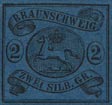 1853. 2 Sgr., black on blue.
1853. 2 Sgr., black on blue.
Genuine
Engraved in epargné, usually rather heavily printed, in black, on thick, blue wove paper, watermarked with a posthorn. The design is the same as that of the 2 Sgr. of the first issue.
Forged
I have only one type of forgery, and only two specimens of it in my possession, so it would appear that this value has not been so often forged as the others. It is nicely lithographed, in black, on blue paper, a little lighter in tint than that of the genuine; no watermark. The type is just the same as that of the first forgery of the 2 Sgr. of 1852, except that I can only make out 17 instead of 18 vertical lines in the oval, to the right of the cross.
1853. 3 Sgr., black on rose.
Genuine
Engraved in epargné, in black, on moderately thick, pale rose wove paper; watermarked with a post-horn. The type is similar to that of the genuine 3 Sgr. of 1852.
First Forgery
Poorly lithographed, in black, on medium wove paper, of a peculiar magenta-pink shade; i.e., pink with a shade of blue in it. There is no watermark. This is the same type as the first forgery of the 1 Sgr. of 1852.
Second Forgery
Lithographed, in black, on thick rose paper, very like that of the genuine, no watermark. It is the same type as the third forgery of the 1 Sgr. of 1852.
1856. Same design. 1 Sgr., black on brown.
Genuine
Engraved in epargné, on rather soft, brown wove paper; watermarked with a post-horn. I have only one specimen by me at this moment, and it appears to be on rather thinner paper than those hitherto described. None of the letters touch each other anywhere. The tail of the R of BRAUNSCHWEIG curls up. There are only two lines of shading on the scroll, immediately to the left of the G of that word, and neither of them touches the top outline of the scroll. The tail of the G of PFENNIG is very different from that of the G of BRAUNSCHWEIG. In the side-ovals, the 1 does not touch the fraction-line, and the 4 does not touch the outline of the oval in either case. The outline of the central oval is solid, from level with the nose of the horse, round below, to level with the lowest point of the tail. The base of the crown bears three jewels; a sort of pearl in the center, with a half-diamond to the left, and a long horizontal line to the right. There are six pearls on each of the side-arches of the crown. There are 20 vertical lines in the oval to the left of the cross, and 16 to the right of it, the sixteenth or outer one being extremely short, and very close to the outer edge of the oval. The piece of ground on which the horse stands does not touch the outline of the oval on either side. There must be about 22 vertical lines between the piece of ground and the lower outline of the oval; but my copy is imperfect here, so I cannot say exactly. The head of the horse is rather thick and clumsy, but with a nice, small eye. The line up the neck is extremely short, being not much more than an oblong dot. The point of the horse’s nose touches the eighth line from the left. The point of the tail, which is not outlined, breaks into the third line from the right.
First Forgery
Lithographed, in black, on thick, brown wove paper; no watermark. This is exactly the same type as the first forgery of the 1 Sgr. of 1852.
Second Forgery
Lithographed, in black, on medium, pale brown wove paper, of a slightly redder tint than that of the genuine. This is exactly the same type as the third forgery of the 1 Sgr. of 1852.
Third Forgery
Lithographed, in black, on stout, hard, brown wove paper, very like the genuine in colour; no watermark. The letters RAU of BRAUNSCHWEIG all touch at their bases. There are three lines of shading to the right of the G; all three of them touch the upper outline of the scroll, and the inner one is short, close to the G, and curved, like a comma without a head. The tail of the G of PFENNIG and that of the G of BRAUNSCHWEIG are both alike. In each of the little side-ovals, the foot- stroke of the 1 touches the fraction-line, and the 4 touches the outline of the oval. The outline of the central oval is solid, from about level with the horse’s ears, round below, to level with the middle of the tail. The base of the crown bears four nearly square pearls. The right side-arch has its outline formed by thick black shading; the left arch has three pearls, apparently arranged as a trefoil. There are 20 vertical lines to the left of the cross, as in the genuine, and 17 to the right of it, the last short line to the right being undecipherable. The piece of ground on which the horse stands touches the outline of the oval to the right. Only about 17 short lines can be seen, between the lower outline of the oval and the bottom of the piece of ground, and the stamp is very blotch) all about the hind feet of the horse. The head of the horse is slim, but the eye is a large black patch. The line up the neck is long, occupying more than half of the distance. The point of the horse’s nose just touches the seventh line from the left. The end of the tail, which is outlined, touches the first line from the right.
1856 & 1864. Same design. 1/2 Sgr., black on white.
Engraved in epargné, on thick, yellowish-white wove paper, watermarked with a post-horn. None of the letters touch each other any- where; but the left side of the footstroke of the R of BRAUNSCHWEIG is particularly long, and very nearly touches the base of the B. The tail of the R curls upwards, and the foot of the A is a good distance from the base of the U. There are only two short, vertical lines of shading in the scroll, after the G of BRAUNSCHWEIG; and these two lines do not touch either the top or bottom outline of the scroll. In the lower scroll, there are two curved lines of shading before the v of VIER; the outer one is very much longer than the other, and it is joined to the head of the V. At the other end of this scroll there are two lines of shading after the PF. The points of this lower scroll are a long way from the bottom of the stamp. In heavily-printed copies, the outline of the central oval is blotched into one thick, solid line, nearly all the way round; but lighter specimens show the lines double for very nearly the whole of the upper half of the oval. There are six pearls at the base of the crown, and six on each of the side-arches. There are 18 vertical lines in the oval, to the left of the cross, and 15 on the right side. The piece of ground on which the horse stands does not touch the oval on either side. There are 18 short, vertical lines between the piece of ground and the outline of the oval below it. The head of the horse is thick and clumsy; the mouth can be seen, but not the nostril, and the eye is distinct. The short, curved line, forming the curve of the shoulder, is well marked, and the line running up the neck is broken in the middle, making it two short pieces, which follow, more or less, the curve of the outline of the back of the neck. The point of the horse’s nose touches the seventh line from the left, and the point of the front hoof comes between the first and second lines from the left. The tail ends with the last line but one on the right, its tip not being outlined.
First Forgery
Lithographed, on medium, rather soft, very white wove paper, no water-mark. The left side of the foot-stroke of the R of BRAUNSCHWEIG is very short, and does not go near to the base of the B; the tail of the said R touches the base of the A, and the A and U are extremely close together at their bases, so as to almost touch. There are three lines of shading after the G—two long ones and one short one—and the long ones reach very nearly from the top to the bottom outline of the scroll. In the lower scroll there are three lines before VIER, and three after PF. None of the lines touch the V. The points of this lower scroll almost touch the outline of the frame below them. The outline of the central oval is very distinctly solid, from level with the point of the horse’s tail, round the bottom of the oval, to rather above the level of his nose. The base of the crown shows five pearls, which are easier to see than in the genuine. There seem to be four pearls on the left arch of the said crown, and none at all on the right arch. There are 20 lines in the oval, to the left of the cross, and 18 to the right of it. The piece of ground on which the horse stands touches the outline of the oval on the right side. There are 19 or 20 short, vertical lines below this piece of ground, between it and the bottom of the oval. The whole front of the horse’s nose is one large black blotch, so that the details of nose and mouth are obliterated. There is a line joining the corner of the eye with the base of the ear. The line forming the curve of the shoulder is weak and too short; and the line running up the neck is not broken in the middle, and is not parallel with either the front or back curve of the neck. The point of the horse’s nose just touches the seventh line from the left, and the tail seems to reach to the very edge of the oval, the tip being outlined.
Second Forgery
Lithographed, on thick, very yellowish-white wove paper, no watermark. The first stroke of the R of BRAUNSCHWEIG is slightly crooked, and the left side of its foot-stroke does not go near the B; indeed, there is hardly any sign of a foot-stroke on that side. There are indications of four broken lines of shading after the G of BRAUNSCHWEIG, and five, instead of three, before the B. In the lower scroll, there are indications of three lines after the PF., they are hardly more than dots. The outline of the central oval is plainly double in the top half, almost from fraction to fraction. The crown is covered by the postmark in my single specimen, so that I can give no details. The vertical lines in the oval are very thin, faint and broken, but there seem to be 20 to left of the cross, and there are 17 to right of it. The piece of ground on which the horse stands is formed by two parallel, straight lines, stretching from one outline of the oval to the other, with three rocks piled on them. The short, vertical lines below the piece of ground are almost invisible; I can only trace portions of three lines. The head of the horse is rather like that of a greyhound with open mouth, and it seems to have a sort of ghastly grin. The upper jaw ends in a sharp point, without any nostril. The thin line up the neck reaches down to the left fore-leg. The point of the front hoof comes between the second and third lines from the left. The tip of the tail is outlined, and it touches the fourth line from the right. The cross on the top of the crown is very conspicuous in this forgery.
Third Forgery
Lithographed, on rather thick, hard, very white wove paper with a regular grain, no watermark. The foot-stroke of the R of BRAUNSCHWEIG is short, and does not go near the B. The top of the G does not come forward enough, and the tail of that letter curls forwards, so as to touch the line of shading to right of it. In the lower scroll, there are no lines at all before VIER, and the stop after PF. is a long way from the first line of shading after it, instead of almost touching it. The outline of the central oval is quite solid all the way round. I can only see five pearls at the base of the crown, but there is a black blotch in my specimen, large enough to cover two more pearls. There are 20 strong lines in the oval, to left of the cross (which is only a black lump) and 17 to right of it. The head of the horse is a little like that of a sheep; the mouth is a small, wedge-shaped gap, and there is a very prominent eyebrow. There are 19 short, vertical lines between the piece of ground and the bottom of the oval. The point of the front hoof touches the second line from the left. The tip of the tail is scarcely outlined, and it comes between the third and fourth lines from the right.
Fourth Forgery
This is altogether bogus. It is nicely lithographed, in black, on deep rose paper, thick, soft, and without gum, no watermark. Of course, in this form, the colored paper instantly condemns it; but, in case it has been, or should be, printed on white paper, I give the following tests of the design. The first two letters of the name are RB instead of BR, and the bases of the B and A are joined together. There is only one line of shading after the G, and the tail of the said G hangs down, so as to touch the bottom outline of the scroll. In the lower scroll, there are three vertical lines before the v of VIER, and the innermost line touches the middle of the V. There are two lines at the other end of the scroll, after the PF, as in the genuine; but the inner one touches the bottom outline of the scroll, and the outer one touches the top outline, which is not the case in the genuine. The outline of the central oval is perfectly solid all the way round. The crown is very different from the genuine, having a knob on the top of the orb instead of a cross. There is a white blotch, instead of pearls, along the base, and the pearls on the side-arches are black, and not to be counted. The knob does not quite touch the outline of the oval above it. There are 18 vertical lines in the oval, to the left of the knob, and 15 to the right of it, as in the genuine; but the right-hand end-line is very short, and does not touch either the top or bottom of the oval. The piece of ground on which the horse stands touches the oval on the right. There arc 19 short lines between it and the outline of the oval below it. The nose of the horse comes between the sixth and seventh lines from the left; it looks very like the head of a Shetland pony ; the mouth is long, but the nostril is invisible. There are some dots running obliquely across the center of the neck, down from right to left, but there is no line running up the neck, as the genuine has. The line forming the curve of the shoulder is quite as thick as one of the legs; i.e., twice as thick as in the genuine. The point of the front hoof very nearly touches the first vertical line on the left, and the tail ends at the third line from the right. Despite all these differences, this stamp, if printed on white paper, would be deceptive.
1857. 4/4 Sgr., black on brown.
Genuine
Engraved in epargné, in black, on thick brown paper, watermarked with a post-horn. This watermark, being the same as before, can only be shown by the four stamps. I describe the stamp as a whole, but it must be remembered that it really consist of four small ones, joined together in one frame. The thin, inner line of the left-hand frame, if prolonged upwards, would pass exactly along the center of the vertical stroke of the P of the left upper POSTMARKE. This said line is very distinctly broken, or interrupted, to allow a passage for the tail of the G of the upper PFENNIGE; and similarly for the tails of the F and G of the lower PFENNIGE, all of which go through it. The inner line of the frame on the right side of the stamp is also broken or interrupted, to allow a passage for the F and G of the upper PFENNIGE, and the G of the lower PFENNIGE. The line down the middle of the stamp is not broken anywhere. None of the crosses on the crowns touch the outlines above them. The interior outlines of the side-arches on all the four crowns are formed by black lines, separated by a space from the pearls on the said arches, and there is a stop after each GUTE GR.; while the tail of the small G of the upper right hand GUTE GR. has lost its “kern”, or little ball at the end of the tail. There is a stop after the right bottom POSTMARKE. The E of the right top POSTMARKE is very close to the tail of the 3 to the right of it, so that the kern to the tail of the 3 would serve very well as the stop after the said POSTMARKE. The fraction-line of the lower right-hand J very nearly touches the lower outline of the containing-oval. If we suppose each oval to be divided into two by the fraction-line in it, then it will be seen that the half containing the little 4 is, in each case, considerably thicker in its outline than the half containing the little 1. The cross on the left upper crown points between the letters M and A of POSTMARKE.
Forged
This is decidedly poor. It is lithographed, on brownish-white, or greyish-white wove paper, moderately thick, no watermark. The thin, inner line of the left-hand frame, if prolonged upwards, would pass very nearly clear to the left of the vertical stroke of the P of the left upper POSTMARKE. This line is broken for the tail of the G of the lower PFENNIGE, but it is simply drawn through the F of that word, and also through the tail of the G of the upper PFENNIGE. The inner line of the right-hand frame is only broken for the tail of the lower right-hand PFENNIGE. The line down the middle of the stamp is broken between the two lower ovals. The cross on the left lower crown touches the out- line above it. There is no separate, inner outline to the side-arches of the four crowns. The right lower GUTE GR. has no stop after it, and there is no stop after the right bottom POSTMARKE. The small G of the right upper GUTE GR. looks very like a Q. The tail of the 3 at the right top corner of the stamp is distinctly lower than the level of the bottom of the E of the right upper POSTMARKE, SO that the ball of the tail of the said 3 is at some distance from the E, and could not serve as a stop to the POSTMARKE. Both lower fraction-lines touch the bottom outlines of their containing-ovals, and the right upper fraction-line very nearly touches the top of its containing-oval. The outlines of all four ovals are, as nearly as possible, the same thickness all the way round. The cross on the left upper crown points to the last limb of the M of POSTMARKE.
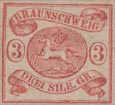 1862 & 1864. 3 Sgr., rose on white; watermark Post-horn.
1862 & 1864. 3 Sgr., rose on white; watermark Post-horn.
Genuine
My young readers will please note that this stamp has the post-horn watermark, and therefore need never be confounded with the first issue. It is engraved in epargné, on medium, white wove paper. The tests for the genuine 3 Sgr. of the first issue will serve for this.
Forged
Lithographed, on thick, very white wove paper, no watermark, unperforated. The type is the same as that of the first forgery of the 3 Sgr. of 1852.
1863 & 1864. 4 Sgr., black on green; watermark Post-horn.
Genuine
Engraved in epargné, in black, on medium to thinnish, green wove paper, watermarked with a post-horn. The outer frame of the stamp is, as in all the other values, composed of a thick and a thin line. None of the letters touch each other anywhere. The horse’s hoof comes between the first and second vertical lines of shading from the left, not counting the tiny line, close to the edge of the oval, which is sometimes visible. The nose touches the seventh line. There are 20 lines to the left of the cross, and 16 to the right of it, not reckoning the said tiny line. The cross itself is very different from that in all the rest of the stamps, both it and the crown having been entirely re-drawn. The said cross is a slim, but very broad, cross pattée, and it breaks through the inner line of the oval, and is joined to the outer line. The arches of the crown have oblong or triangular blotches, instead of the pearls; and the blotches on the outer arches are drawn standing out, as a sort of prickly fringe. The whole of the lower half of the outline of the central oval is one solid line. The piece of ground on which the horse stands does not touch the oval on either side, and there are 19 or 20 short, vertical lines between it and the bottom outline of the oval. Of the little black upright ovals, the one on the left is decidedly nearer to the central oval than to the frame; but the one on the right is about equidistant from the central oval and the frame. The fraction-line of the 1/2 is very distinct, and rather short, so that it does not anything like touch the sides of the containing-oval. The G of GR. is very slim, but nicely shaped, and there is a distinct stop after the R, not touching the R. The diaeresis over the U of FUNF does not touch the outline of the scroll above it; the G of PFENNIG has a curiously-shaped tail, which curls forward, so as very nearly to touch the stop after that word, and the said stop is hardly visible, as it is almost entirely hidden by the vertical lines of shading in the end of the scroll.
First Forgery
Lithographed, on rather thick, coarse, green wove paper, no watermark. The inner line of the frame is so very thin that it is almost invisible on the left side. In the word BRAUNSCHWEIG, the R and A are joined at the bottom, and the w and E are joined at the top. The horse’s hoof touches the third line from the left. The nose of the horse touches the ninth line from the left. The crown has a sort of lump on the top of it, and the lump does not touch the top of the oval. There are 42 lines in the oval altogether. The horse’s tail touches the fourth, instead of the third line, from the right. The crown is the same as in the third forgery of the 1 Sgr. of 1852. The only portion of the outline of the central oval which is solid is that part immediately under the piece of ground on which the horse stands; all the rest is composed of two lines. The hindmost hoof of the horse seems just to touch the outline of the oval to the right. There are 21 short lines, between the piece of ground and the bottom outline of the oval. Of the little black ovals, the one on the left is nearer to the thin outline of the frame than to the outline of the central oval; and the one on the right is very much nearer to the central oval than to the outline of the frame. The fraction-line of the 1/2 goes rather close to both sides of the oval. The G of GR, is almost equally thick all the way round; whereas, in the genuine, it is merely a hair-line at the top and bottom, getting gradually thicker in the middle. The foot of the R is lower than that of the G, and there is no stop after the R. The diaeresis over the U of FUNF touches the outline of the scroll above it, and there seem to be three dots instead of two. The G of PFENNIG has an ordinary tail, which does not go near the stop, and the stop is not covered by the shading, there being only one line which touches it.
Second Forgery
This is a frightful thing. Very badly lithographed, on thin, soft, apple-green wove paper, showing very coarse and distinct meshes of the wire-gauze on which it was made. There is, of course, no watermark. On the left side, the two outlines of the frame are very nearly of equal thickness. The RA and WE of BRAUNSCHWEIG touch each other, as in the first forgery. The horse’s hoof, which is very much curved downwards, touches the third line from the left; the nose touches the ninth line. There are 42 lines in the oval altogether; as the crown, which is like that of the first forgery, does not touch the top of the oval. The outline of the central oval is solid, from level with the horse’s chest to above the P of PFENNIG; then it is double above the E, and then solid again to above the second N. The piece of ground seems to touch the oval both sides, and there are 20 or 21 lines between it and the bottom outline of the oval. The position of the little black ovals is the same as in the first forgery. The fraction-line of the i goes near to the right edge of the oval, but not to the left one. The G of GR. is a clumsy imitation of the genuine, and the stop after the R is joined to the base of the R. The diaeresis over the U of FUNF is joined to the outline of the scroll above it. The G of PFENNIG has an ordinary tail and a broken head. There is no stop after the G. This counterfeit is not likely to deceive.
Third Forgery
This is, if possible, worse than the last. Very badly lithographed: paper the same as in the second forgery, but lighter in shade. There is no watermark. Both outlines of the frame are almost equal in thickness on the left side. The R and A of BRAUNSCHWEIG touch each other at the bottom, and the first four letters of that word touch the outline of the scroll, either above or below, or both. The horse’s hoof touches the third line from the left, and the nose, as far as I can make out through the post- mark, touches the eighth line. The ninth and tenth lines are drawn right through the nose. There seem to be 37 lines in the oval altogether. I cannot say anything as to the shape of the crown, as the postmark just covers it. The outline of the central oval is solid all the way round. The horse’s tail apparently touches the third line from the right. I can say nothing further of the central oval, as it is so faint and indistinct. The black oval on the left very nearly touches the outline to the left of it, and the similar oval on the right very nearly touches the outline to the right of it. The fraction-line of the J is so thin, as to be almost invisible. The G of GR. is somewhat like that of the second forgery, but with a larger and better head; the foot of the R is much lower than that of the G, and there is only a very faint indication of a stop after the R. The diaeresis over the U of FUNF does not touch the outline of the scroll above it. The G of PFENNIG and the stop after it are the same as in the first forgery. This is one of the coarsest forgeries that I have ever seen, and hardly deserving of description.
 1864. 1 Sgr., yellow, orange-yellow, on white.
1864. 1 Sgr., yellow, orange-yellow, on white.
Genuine
Engraved in epargné, in yellow or orange-yellow, on thick, white wove paper; watermark post-horn. The type is the same as that of the genuine 1 Sgr. of 1852. The execution is always very faulty, being blurred and indistinct, so that the details of the design are very difficult to make out.
First Forgery
Lithographed, in yellow, on medium, white wove paper, no watermark, unperforated. The type is exactly the same as that of the first forgery of the 1 Sgr. of 1852.
Second Forgery
Badly lithographed, in yellow, on thick, white wove paper, no watermark, unperforated. The outer frame of the stamp appears to consist of three lines, all blotched together into one very thick line. The outline of the central oval is formed of one thick line, all the way round. There is no line running up the horse’s neck; the front hoof appears to touch the third vertical line from the left. There are about 17 vertical lines to the left of the cross, and the horse’s nose touches the eighth line from the left. There are no vertical lines under the piece of ground, between it and the bottom outline of the oval; and the bottom of the tail of the G of BRAUNSCHWEIG touches the outline of the scroll below it. The stamp is so badly printed that I have not been able to make out any other details.
Third Forgery
Lithographed, in ochre-yellow, on stout, vertically-laid white paper, the laid lines being very unusually close together. I suppose I need not say that no Brunswick stamp was ever issued on laid paper. The type of the stamp is exactly the same as that of the third forgery of the 1 Sgr. of 1852.
Postmarks
Genuine.—29, 30, 71; also one similar to 34, but with an open space in the center.
Forged.—Similar to 96, but very much larger; also imitations of the genuine; also 1.
From: ‘Album Weeds’, 3rd edition by R. B. Eareé. 1906
![]() See also —> Spud Papers – Braunschweig (Brunswick)
See also —> Spud Papers – Braunschweig (Brunswick)

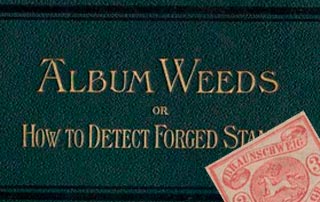
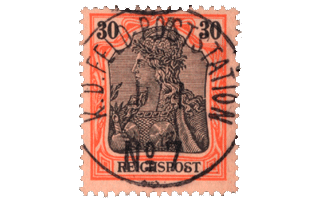
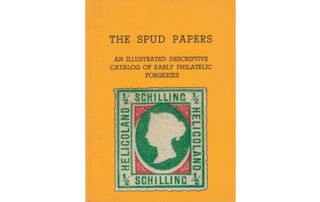
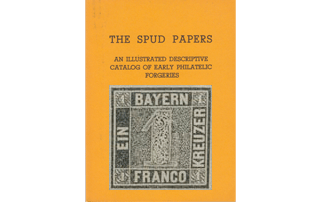
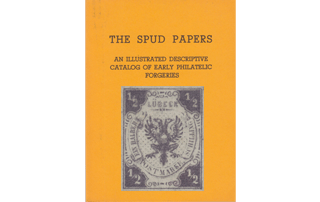
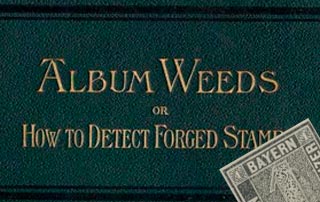
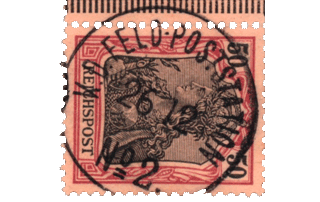
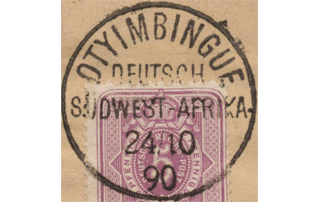
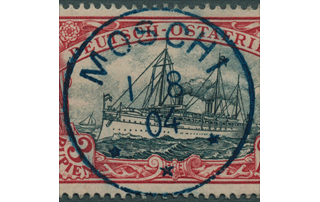
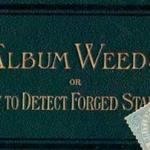
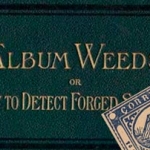
Leave a Reply
Want to join the discussion?Feel free to contribute!